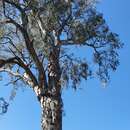fi
nimet breadcrumb-navigoinnissa


Melaleuca fluviatilis is a plant in the myrtle family, Myrtaceae and is endemic to northern Queensland in Australia. It is a tree with papery bark, narrow leaves and spikes of white or creamy-coloured flowers, usually growing along streams and rivers. It is common in tropical areas and is sometimes confused with Melaleuca argentea although it lacks that species' silvery foliage.
Melaleuca fluviatilis is a tree growing up to 30 m (100 ft) tall with white or greyish papery bark and weeping habit. Its leaves are arranged alternately, 45–180 mm (2–7 in) long and 5–19 mm (0.2–0.7 in) wide, very narrow elliptical in shape and with 5 to 7 parallel veins. Both surfaces of the leaf are covered with fine, soft hairs when young but become glabrous as they mature.[2][3][4]
The flowers are white to creamy green and arranged in spikes in the upper leaf axils. Each spike contains 3 to 18 groups of flowers in threes and is up to 100 mm (3.9 in) long and 40 mm (1.6 in) in diameter. The petals are 1.5–3.5 mm (0.06–0.1 in) long and fall off after the flower opens. The stamens are arranged in five bundles around the flower, each bundle containing 3 to 9 stamens. Flowers appear from May to October and are followed by fruit which are woody capsules 2.5–4 mm (0.1–0.2 in) long.[2][3][4]
Melaleuca fluviatilis was first formally described in 1997 by Bryan Barlow in Nomen from a specimen found in a sandy river bed north of Townsville.[4][5] The specific epithet (fluviatilis) is a Latin adjective meaning "pertaining to rivers".[2]
This melaleuca is found throughout the Cape York Peninsula and as far south as Gladstone and Biloela, and as far west as Croydon, Boodjamulla National Park and Forest Den National Park. It grows in a range of soils but usually along rivers and streams and the edges of swampy open forest, often in association with rainforest or dry sclerophyll species.[2][3][6]
Melaleuca fluviatilis is a plant in the myrtle family, Myrtaceae and is endemic to northern Queensland in Australia. It is a tree with papery bark, narrow leaves and spikes of white or creamy-coloured flowers, usually growing along streams and rivers. It is common in tropical areas and is sometimes confused with Melaleuca argentea although it lacks that species' silvery foliage.
Melaleuca fluviatilis (Barlow, 1997) è una pianta appartenente alla famiglia delle Myrtaceae, endemica del nord del Queensland in Australia[1].
Si tratta di un albero con corteccia cartacea, foglie strette e punte di fiori bianchi o color crema, che cresce di solito lungo le rive dei corsi d'acqua. È comune nelle aree tropicali e viene talvolta confusa con la Melaleuca argentea, sebbene manchi del fogliame argenteo di quest'ultima.
Melaleuca fluviatilis è un albero che può crescere fino a 30 metri di altezza con corteccia cartacea bianca o grigia e aspetto piangente. Le sue foglie sono disposte sui rami alternativamente, lunghe circa 180 mm e larghe da 5 a 19 mm, di forma ellittica molto stretta e con da 5 a 7 venature parallele. Entrambe le facce delle foglie sono ricoperte di una bella e soffice peluria quando sono giovani, ma divengono glabre con la maturità.[2][3][4]
I fiori sono di un colore che va dal bianco al verde cremoso e sono sistemati in punte sull'asse delle foglie. Ogni punta contiene da 3 a 18 gruppi di fiori a terne e può raggiungere una lunghezza di 100 mm per un diametro di 40. I petali sono lunghi da 1,5 a 3,5 mm e cadono quando i fiori si aprono. Gli stami sono raggruppati in fasci attorno al fiore, ciascuno dei quali contiene da 3 a 9 stami. I fiori compaiono da maggio ad ottobre e sono seguiti da frutti in capsule lunghe da 2,5 a 4 mm.[2][3][4]
Questa specie di melaleuca si trova sulla Penisola di Capo York, a sud a Gladstone e Biloela, e a ovest a Croydon, nel Parco Nazionale di Boodjamulla e in quello della Foresta Den. Essa cresce in un'ampia gamma di tipi di terreno, ma usualmente lungo corsi d'acqua e ai margini di foreste paludose, spesso in associazione con foreste pluviali o specie di sclerofillo[2][3][5].
Melaleuca fluviatilis venne formalmente descritta nel 1997 da Bryan Barlow in Nomen da un campione trovato nel letto sabbioso di un fiume a nord di Townsville[4][6].
Melaleuca fluviatilis (Barlow, 1997) è una pianta appartenente alla famiglia delle Myrtaceae, endemica del nord del Queensland in Australia.
Si tratta di un albero con corteccia cartacea, foglie strette e punte di fiori bianchi o color crema, che cresce di solito lungo le rive dei corsi d'acqua. È comune nelle aree tropicali e viene talvolta confusa con la Melaleuca argentea, sebbene manchi del fogliame argenteo di quest'ultima.
Melaleuca fluviatilis là một loài thực vật có hoa trong Họ Đào kim nương. Loài này được Barlow mô tả khoa học đầu tiên năm 1997.[1]
Melaleuca fluviatilis là một loài thực vật có hoa trong Họ Đào kim nương. Loài này được Barlow mô tả khoa học đầu tiên năm 1997.